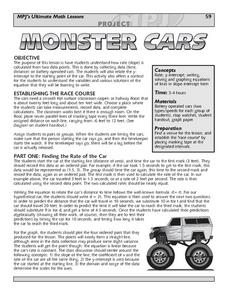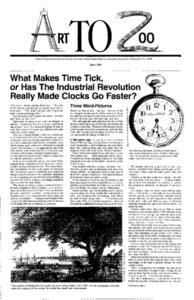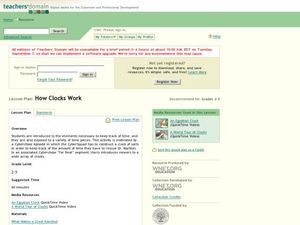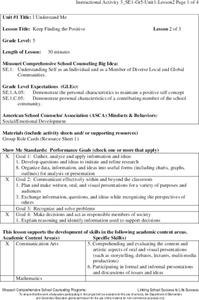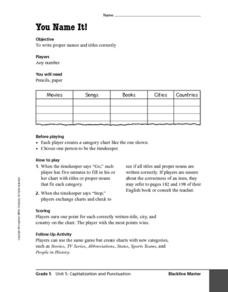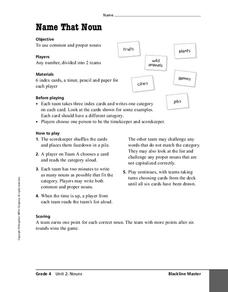Institute of Electrical and Electronics Engineers
Pendulum Time
Take your time with this lesson. Junior engineers read about different types of clocks and then work together to build a pendulum time-keeper. There are no hints as to how they might go about accomplishing this complex task, so you may...
International Technology Education Association
Reinventing Time
Take a trip through time. A lesson resource provides instruction on the origin of current measurements for time. The text explains the different tools humans used throughout history to measure time as well as provides examples such as...
Curated OER
Telling Time Timeline
Use the Internet and library resources to compose a telling time timeline -- a visual history of time. Young scholars will develop research skills and gain perspective about telling time by discovering the history of clocks and time.
Curated OER
Keep Track of time by watching the clock
Students answer questions about the clock. In this time lesson, students answer questions using intervals of five minutes. Students solve problems about how long to the next activity, how much longer, and whether or not we have...
Curated OER
Monster Cars: Slope
Students examine how a rate is calculated from two points. Using battery operated cars, pairs of students measure time and distance. Afterward, they use this data to calculate the rate. Students then plot four ordered pairs and discover...
Curated OER
What Makes Time Tick, or Has the Industrial Revolution Really Made Clocks Go Faster?
Learners explore the concept of time both historically and in their own lives. Students count the number of times they refer to a clock and the number of scheduled and unscheduled activities in their lives. Learners discuss how the...
Curated OER
How Clocks Work
Young scholars discover time pieces and complete telling time activities. In this time lesson, students complete a worksheet about what make a clock keep time. Young scholars watch a video about time and clocks as well as a video about...
Curated OER
Good Timing
Students investigate time, how people measure it, and how it influences our lives. They complete an online Webquest, analyze various calendars, answer discussion questions, and identify references to time in a newspaper article.
Curated OER
Timekeeping by the Sun
Students measure shadows to learn about the Sun-Earth relationship. In this astronomy lesson, students create a shadow stick of a Pokemon character and record measurements of its shadow in a data chart. Follow-up discussions guide...
Curated OER
Time for All Ages
Fourth graders discover time keeping by analyzing technological advances in history. In this time instructional activity, 4th graders create and complete a KWL chart based on their research of a famous timekeeping invention, such...
Curated OER
Swing in Time
Students examine the motion of pendulums and come to understand that the longer the string of the pendulum, the fewer the number of swings in a given time interval. They see that changing the weight on the pendulum does not have an...
Missouri Department of Elementary
Keep Finding the Positive
Group members take on roles to create a positive classroom community. Learners perform their role—leader, recorder, presenter, timekeeper, encourager, and collector—in preparation for a formal presentation of their positive thinking...
Curated OER
How Many in a Minute
Students estimate what they can accomplish in a minute. In this estimation activity, students guess how many jumping jacks or stars they can draw in a minute. They get timed and see how close they are to their prediction.
Curated OER
Days of the Week
Students participate in a variety of center activities to reinforce the concept of days of the week and their succession. The concept of time can also be taught at the same time to introduce timekeeping.
Curated OER
Knowing North: Understanding the Relationship Between Time and The Sun
Students determine how to find North using a watch and their shadow. In this finding North lesson plan, students go outside on a sunny day and work with their shadow and a wrist watch to find out which direction that North is. They...
Curated OER
Long Day?
Learners become aware of the effects of tides on the Earth's rotation. In this tides lesson, students calculate the number of seconds lost over various periods of time.
Nuffield Foundation
Measuring Rate of Water Uptake by a Plant Shoot Using a Potometer
How quickly does a plant transpire? Learners explore this question through measuring water uptake with a potometer. They time the movement of a bubble a set distance to understand the motion and rate of speed.
Curated OER
Global Change- Time and Cycles
Students study trees and their growth. In this investigative lesson students work in groups to reconstruct a 50 year climatic history using a simulated tree ring.
Curated OER
Classroom Lincoln-Douglas Debate
Unfamiliar with the Lincoln-Douglas Debate format? Check out this resource that details the procedures of the debate, the roles and responsibilities of each participant, and the timing of each round.
Curated OER
You Name It!
In this proper nouns worksheet, students are timed to write as many movies, songs, books, cities, and countries as they can. Students get points for the correct words they write.
Curated OER
Sentence Scramble
In this grammar worksheet, students use cards with words on them to arrange correctly to make complete sentences. Students do this in teams and are timed to get points.
Curated OER
Turn of the Century: Songs and Events from 1900 to 1920
Students research songs and events from the time period 1900 to 1920. They work in groups to create visual displays of the songs and historical references. At the conclusion of the unit, a concert will be held to perform the songs and...
Curated OER
Name That Noun
In this nouns worksheet, students use noun cards to identify types of nouns and write lists of nouns while they are being timed. Teams compete against each other.
Curated OER
Where Are The Verbs?
In this grammar worksheet, students search for action verbs in a word search and write them on the lines provided. Students are timed for 3 minutes to do this.






